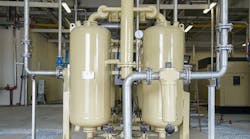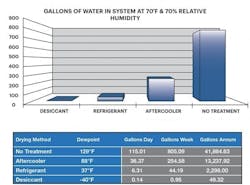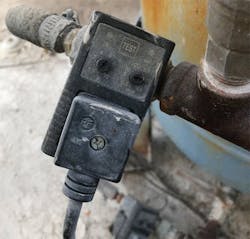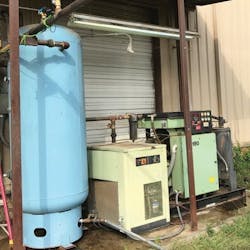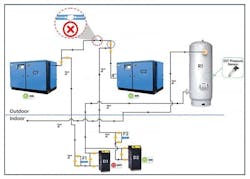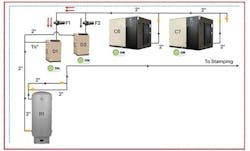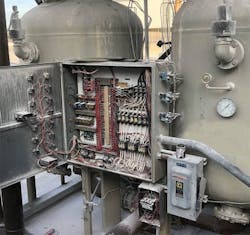Common problems with compressed air drying systems
We have all heard the saying, “You don’t build a house from the roof down.” When it comes to a compressed air system, the same can be said about the dryer(s). In both cases you’d be right; I don’t think there’s one of us that could argue the importance of a roof or a dryer for their respective jobs – to keep the water out!
The trouble with a compressed air system is that the dryer is often a neglected piece of equipment. Looking at a sample size of the last 88 plants audited for compressed air efficiency by Motion Industries Energy Services Team in the last 24 months, we found that 53 facilities had at least one failed dryer on-site. Keep in mind, most plants taking advantage of an air audit are those that are taking a more progressive approach in managing their compressed air systems. Yet in 60% of this sample size, an abundance of water was wreaking havoc on the pneumatic systems in those plants.
Figure 1 illustrates how much water can condense in a system based on the type of dryer, or method of moisture removal, in a compressed air system. Calculations were done assuming 1,000 CFM, or approximately 250 hp at full load.
Luckily, modern-day air compressors all come fitted with an aftercooler, which performs the majority of the work. A general rule is that for every 20 °F rise in temperature, the air can hold twice the moisture load in a vapor state above dewpoint. During compression, an oil-injected rotary screw will discharge compressed air at approximately 200 °F. The aftercooler will cool that air to within 15 to 20 °F of ambient temperature. Generally, this will remove about 75% of the moisture.
In reference to the provided calculation, the aftercooler reduces the amount of water passing through the system from 805.09 gallons per week to 254.58, or almost 69% of the way based on the variables input into the calculator. Depending on the facility’s water content standards that have been established, a dryer is necessary to perform the rest of the work.
What type of dryer do I need?
There are two main types of dryers industrial operations use – refrigerant or desiccant. As illustrated in Figure 1, both take out the majority of the remaining water content. A desiccant-style dryer will leave virtually no water behind; but as I will discuss later in this article, it comes at a cost.
A refrigerant dryer uses a refrigerant circuit and heat exchanger(s) to condense and remove water. These dryers will provide a dewpoint somewhere between 34 to 50 °F when working properly and consume no compressed air in the process. These units have a relatively low operating cost and initial investment. As a result, refrigerant dryers are the most common type of dryer found in a system, accounting for approximately 95% of compressed air systems in use.
How these dryers work can be likened to dew on grass on a spring morning, or the moisture that condenses on a cold beverage outdoors on a hot day. In either case, warm air hits a cool body, and moisture condenses out of the air and collects on the surface of that body.
A desiccant dryer uses desiccant beads to adsorb the moisture, and can provide a dewpoint between -40 °F and -100 °F. However, as the surface area of the desiccant beads surface is covered by moisture, they need to be regenerated – hence the need for two towers in a standard desiccant dryer. One bed is the working bed, while the other is regenerating. The regenerating side uses energy to remove that moisture, which can be accomplished using the compressed air itself, heat, and/or an electrical blower, to name a few. A typical heatless regenerative desiccant dryer will consume 15% of the dryer capacity (cubic feet per minute, or CFM) to regenerate the desiccant bed, which can be extremely costly! Nonetheless, there are systems that require this level of dry air, such as certain food processing and pharmaceutical industries, in which the high costs of these dryers are just the cost of doing business.
Think of the desiccant beads like a group of round sponges. As moisture flows across the material, the sponge will absorb that moisture. Over time, the sponge becomes fully saturated and unable to absorb any more moisture – which is why the beads must be dried internally through the regeneration process to maintain functionality. The difference in a desiccant bead is that it adsorbs instead of absorbs, making the moisture stick to the outside surface area of the bead.
What are some common dryer problems?
Although an air dryer is a critical piece of equipment to keep unnecessary costs like these down, it is often neglected. Some of the ramifications of nonexistent or bad dryers include the following: premature pneumatic failure, larger leak loads, product contamination, rust, ice, worn seals, washed-out lubrication, and clogged baghouses.
All paths lead to higher operating costs, whether that is the cost of a leak, added maintenance, scrap rate, or new equipment. Let’s take a look at some of the most common problems with compressed air drying systems.
1 – Clogged or failed drain(s). One of the easiest ways to compromise the performance of a refrigerant dryer is a clogged drain. If a drain will not open or actuate, then there is nowhere for condensed water to escape. Eventually that water will make its way into the pneumatic system. Think of it like a clogged gutter. The downspout is designed to push water away from the house during a rainy day. If it is clogged, the water will overflow and hit the foundation of the house. Over time, this water will cause foundational problems. In a compressed air system the pneumatic components, product, or processes can become the victims of poor air quality, in this case – excessive moisture (see Figure 2).
2 – High inlet and/or ambient temperatures. Another common cause of failure is high inlet and/or ambient temperatures. A dryer is rated for what is known in the industry as the three 100’s – 100 psig, 100 °F inlet temperature, and 100 °F ambient temperature. Any deviation from these variables in the wrong direction can hinder performance of the dryer.
Figure 3 shows an example of an outdoor compressed air system, surveyed in Arkansas. The state’s hot, ambient conditions already wreak havoc on compressed air systems. Couple that with the sun beaming directly on the compressor and dryer throughout the day, and this is easily a recipe for disaster. It came as no surprise that, when tested, the dryer yielded an elevated dewpoint. Heat is a dryer’s worst enemy, so it is imperative that a dryer is not in a position to experience heat above the unit’s designed specifications – whether that be the compressor exhaust, ambient heat, or in this case, sunlight. When designing an installation location, engineering should ensure a dryer is not susceptible to high heat.
3 – Improper dryer sizing. During a separate survey, there was a system operating with two load/no-load compressors rated for 800 CFM; and the compressors were as working with two dryers, one rated for 800 CFM and the other for 500 CFM. Load/no-load compressors generate one of two flows, it is either all or nothing, so anytime compressor 1 (C1 – 800 CFM output) ran, dryer 1 (D1 – 500 CFM capacity) was overloaded (see Figure 4).
For two days during the survey, a compressor technician was performing service on the smaller dryer. Site personnel did not review or consider the nameplate data. This dryer would never perform to standard anytime compressor 1 was running, no matter how much service was put into the dryer. Note: it is important to consult a dryer sizing chart that would consider pressure, inlet temperature, and ambient temperature when properly sizing the dryer.
4 – Poorly designed infrastructure. In a separate assessment example, the system was actually equipped with dryers sized appropriately for the upstream compressor demand. However, the piping infrastructure forced the majority of compressed air through dryer 1. The result: the dryer was not performing to standard.
Compressed air will follow the path of least resistance. With this current design, it is important to consider what will need to occur in order to change the natural air path toward dryer 2 (see Figure 5). The answer: only a strong enough pressure differential. I like to draw the analogy to a standard highway. If a vehicle’s destination was stamping (bear with me here), the only reason a car would get off the “ramp” to go to dryer 2 is because of a traffic jam.
The trouble is that dryers have oversized components to reduce pressure loss across the equipment. So the traffic jam, or pressure loss, is not going to occur at the capacity of the dryer. In this case, the infrastructure was not engineered properly, leading to dryer 1 seeing more air for which it is rated. The result: excessive water making its way downstream. Some slight piping changes could address this, and lead to a more balanced share of the load across both dryers.
5 – Service needed! Just like any other mechanical component, regular maintenance is required. In the case of one dryer we surveyed, it was screaming, “Help!” A drain can be clogged, dryer coils can be dirty, refrigerant may need to be recharged, desiccant is in need of changing, or a slew of other issues. When regular care is not done, performance will erode to unacceptable levels.
Each picture in Figure 6 highlights that the dryer needs service. Most glaring to a professional is the dewpoint at 57 °F. The particular dryer that these images were taken is refrigerated and rated to dry the air to 38 °F. At 57° F, this is 19 °F higher than the rating and should be a flag that service is required. Check your manufacturer’s instructions to determine the acceptable drying levels for your specific dryer.
6 – Simply needs replacement. Much like anything that is mechanical in nature, a dryer has an expected lifetime. At some point, the investment of a new component outweighs that of ongoing repair. Using the dryer pictured in Figure 7 as an example, there was a laundry list of issues which forced the facility to bypass the unit in order to perform scheduled maintenance. The age is depicted across the entire desiccant dryer. There is contaminant that has even made its way into the panel. The technician came on-site to troubleshoot the dryer, and after a thorough assessment, determined that it was beyond repair and simply needed to be replaced.
Improper fixes
Beyond the fact that dryers are often neglected, there are also times that a quick-fix is administered, instead of performing the necessary service to ensure the unit is working to standard while prolonging the life of the dryer.
Secondary, or Point-of-Use Dryers. Oftentimes, point-of-use dryers are identified during a systemwide assessment, because there are times that these dryers are required and effective. However, we have found that point-of-use dryers are repeatedly put in place because an operator is complaining about water in the lines making its way into the process itself.
In turn, the plant would make the (not optimal) decision to install a point-of-use dryer. This is like having a roof leak and instead of fixing the roof, you build a separate roof within your house. Sure, it may help water from not infiltrating that area of the house, but is it the right fix? Absolutely not! What good is a second roof when the walls are deteriorating?
In terms of a plant, the rest of the facility is still getting hit with water. To make matters worse, a dryer is designed to remove water vapor, not bulk water. So if by that point in the operation bulk water is hitting the point-of-use dryer, bulk water is going to leave the dryer. The model solution would be to address the root of the problem (the mainline dryers), to prevent further problems and lost revenue.
Solution Overkill. Another common mistake is a statement I hear often: “We need desiccant!” Often, refrigerant dryers have been severely neglected for years, and the “water lines have air in them,” is the joke. Someone is fed up, and believes desiccant is the answer.
The trouble is that they will be right back where they started if the new desiccant dryer is also neglected. Furthermore, only select operations actually require desiccant dry air. Above and beyond the higher initial cost, there is also a much greater operating cost due to the nature of these dryers. In some ways, it is like buying an industrial-grade roof for your house. It’s complete overkill, but if money is not a concern, it is an option. The trouble is that businesses, just like our households, don’t have an unlimited supply of money – so it is not really the appropriate solution.
So what are my options?
First, get those involved at the facility who oversee the compressed air system. Stop putting a bandage on the knife wound, and treat it at the source instead of on the plant floor, which requires personnel responsible for the compressor equipment. If this personnel is not sure, I highly encourage consulting a professional. Experts in the industry can quickly identify problems like those outlined through this article. If these options are exhausted, then guidance toward the appropriate drying solution can be proposed so that you are not purchasing beyond what is necessary. There are several resources out there from professional groups from distributors and OEMs to field specialists.
Dryers are not the most important part of the system, but like a roof, they are a critical component to the overall reliability and sustainability of the system – and should be treated as such.
